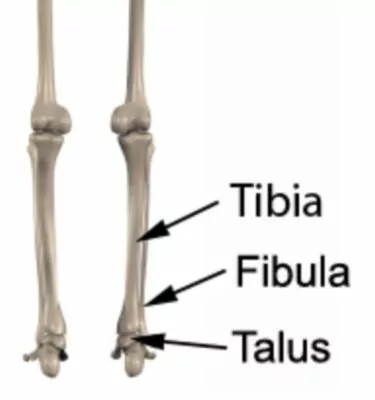Fibula Anatomy: Understanding the Smaller Bone in the Lower Leg
Updated:
The fibula is the smaller of the two long bones in the lower leg and plays an important role in providing stability to the ankle joint. In this article, we will explore the anatomy of the fibula, including its bony landmarks, muscular attachments, common injuries, and treatments.
Fibula Anatomy – Bony Landmarks
The fibula is a long, thin bone that runs parallel to the tibia on the outer side of the leg (figure 1). It has a narrow head that articulates with the tibia and a wide distal end that forms the lateral malleolus, which is the bony prominence on the outside of the ankle joint.

Fibula anatomy – Muscular Attachments
Several muscles attach to the fibula, including the peroneus longus and peroneus brevis muscles, which are located on the outer side of the leg and are responsible for ankle eversion, or turning the foot and ankle outward. The biceps femoris muscle in the thigh also attaches to the fibula via the fibular head. These muscles help to stabilize the ankle joint and provide movement to the foot and bend the knee joint.
Common Injuries affecting the Fibula
The fibula is susceptible to a variety of injuries, including fibula fractures, fibula stress fractures and ankle sprains. Fibular fractures can occur due to trauma, such as a fall or car accident, or as a result of a sports injury. Ankle sprains, on the other hand, occur when the ligaments that connect the bones of the ankle are stretched or torn typically during a rolled ankle (i.e. inversion injury).
Treatment for fibular injuries may include rest, ice, compression, and elevation (RICE), physiotherapy, and in some cases, surgery. Physiotherapy can be particularly helpful for restoring leg strength, mobility and function after an injury or surgery and optimising rehabilitation to minimise pan and accelerate recovery.
In conclusion, the fibula may be the smaller bone in the lower leg, but it plays an important role in providing stability to the ankle joint and allowing for movement in the foot. By understanding the bony landmarks, muscular attachments, and common injuries associated with the fibula, patients can better care for their legs and prevent injuries. If you have any concerns about your leg health, be sure to consult with a qualified healthcare provider.
References
- Fibula anatomy by Teach Me Anatomy – https://teachmeanatomy.info/lower-limb/bones/the-fibula/
- Moore KL, Dalley AF. Clinically Oriented Anatomy. 7th ed. Philadelphia, PA: Lippincott Williams & Wilkins; 2014.
- Drake RL, Vogl AW, Mitchell AW. Gray’s Anatomy for Students. 2nd ed. Philadelphia, PA: Churchill Livingstone/Elsevier; 2010.
- Magee DJ. Orthopedic Physical Assessment. 6th ed. St. Louis, MO: Elsevier Saunders; 2014.

Link to this Page
If you would like to link to this article on your website, simply copy the code below and add it to your page:
<a href="https://physioadvisor.com.au/fibula-anatomy”>Fibula Anatomy: Understanding the Smaller Bone in the Lower Leg – PhysioAdvisor.com</a><br/>
Return to the top of Fibula Anatomy: Understanding the Smaller Bone in the Lower Leg.
